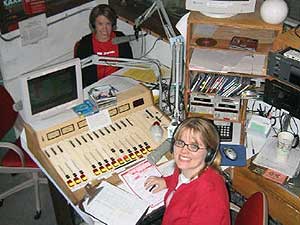| The Independents |
KAXE thrives as an independent radio station
October 11, 2004
 |
| Stephanie Rose (left) and Heidi Holtan (right) in KAXE's on-air studio. (Photo courtesy KAXE) |
Grand Rapids, Minn. — Thirty years ago, the woods around Grand Rapids were home to lots of wildlife, and a few loggers.
Then came the back-to-the-landers. People like Maggie Montgomery, who drove up from Ohio in a van, to try to make a living off the land.
"I lived for three years with no running water or electricity, and three children, and was out of my mind," she recalls. "And at that time of course there were no public radio stations in northern Minnesota. KAXE went on the air in 1976, and that was a big deal, and actually it also saved my sanity!"
That's what you'll hear from a lot of people who moved here to raise llamas or make pots or wooden furniture. Land was cheap and beautiful. But there wasn't much entertainment. No foreign films, no cable TV, not even a daily paper.
 | |||
And then a group of people decided to build KAXE. The FM station is full of hip music and local color.
One of the most popular programs is the phenology show, hosted by John Latimer. Latimer has a rural route delivering the mail. But once a week he goes on the air at 5 a.m., to host the morning show and talk about natural changes through the seasons.
On one recent show, he warned listeners to watch out for garter snakes sunning themselves on the country roads. He says they look like sticks, "and then at the last second you realize it's a snake, and you have to throw the car into some evasive maneuver to avoid running over it."
Latimer has been doing the show as a volunteer for 20 years.
Maggie Montgomery has also been involved in KAXE for years. She started as a volunteer, and now she's the station manager. She says the station attracts a loyal following because it helps people in practical ways.
 | |||
"I've talked to people who've moved here and said, 'By listening to KAXE, I finally felt at home here. I started to understand what was going on around me, I started to know about community events here. I started to understand what those flowers were that were blooming in my ditch, what I could expect in terms of weather, and who I could call when I had deer in my garden. I've never had this before, my hostas are being eaten!'"
Most of the announcers on KAXE are volunteers. They play almost any kind of music you can imagine. Some shows are devoted to women's music, '60s and '70s rock, or bluegrass. Other shows offer a mix of blues, rock, jazz and folk.
The schedule has changed over the years, and so has the way the station is managed. For years, KAXE was constantly in debt. Once a truck knocked over the transmission tower, and there was a desperate struggle to recover financially.
Scott Hall, host of the morning show, says in those days, the people running the place were inexperienced, including himself. He was on the board of directors when the tower came down.
"I remember our membership drives," Hall says. "I would just sit there and shake my head because people were still listening, still pledging. It was almost like they wanted us to survive as much as we did."
|
(City officials) said what an asset KAXE was, and they were just so excited to have us here. We had no idea they felt that way about the radio station and its impact on the community.
- Maggie Montgomery, KAXE general manager |
Those die-hard listeners kept the station going. Art Norton has been listening ever since he moved to the woods 24 years ago.
"We lived in a cabin that didn't have any electricity, but we did have a radio. We still live off the grid -- we have solar power," says Norton. "But I have real fond memories of listening to KAXE on Saturday nights in the cabin. Listening to the BBC radio readers program, and they did the "Lord of the Rings" trilogy, and they were just terrific -- so that was our Saturday night entertainment."
These days, the staple on Saturday is a trivia program. It's called "Green Cheese." There are no prizes, and all the questions are supplied by listeners.
Some people play the game in groups, and give themselves colorful names like Brainerd Bong Blazers, the Southeast Campfire, and the Afton Brain Trust.
Julie Crabb is a volunteer host for "Green Cheese." She drives from Meadowlands, 50 miles away, to do the show.
"We have people listening on docks; I've had people call from boats, from icehouses," Crabb says.
People call from out of state, listening on the Web, and say hello to friends and family in the northwoods.
 | |||
KAXE has eight paid staff people and dozens of volunteers. They're all crammed into a former classroom at the community college in Grand Rapids. They've carved the space into offices the size of closets. Every square inch is packed. There's not enough room for all the music on the shelves, so plastic storage boxes are stuffed with CDs.
The tiny control room has windows that let in the afternoon sun, but they don't open. So there's a fan that comes on whenever the microphone is turned off.
"It keeps (announcer) breaks short during the summer," says Maggie Montgomery, "because people sweat in here, because it's so hot."
In fact, she worries one of the older volunteers might have a heart attack.
That's one reason why KAXE is moving into a brand new building. It's right next to the Mississippi River in downtown Grand Rapids. Montgomery says the city asked the station to build here, and turned over a piece of land for KAXE and a small amphitheater.
"It was like being reborn in the community," she says, "because they said what an asset KAXE was, and they were just so excited to have us here. We had no idea they felt that way about the radio station and its impact on the community." KAXE still has to work hard to survive. But for several years the station has been in the black. There's even a couple of months' worth of operating money in the bank.
Life has changed around Grand Rapids since KAXE went on the air. You can get espresso now. There's satellite TV and the Internet.
But during each pledge drive, more people call to join KAXE. And the old back-to-the-landers are still listening. Every day, Maggie Montgomery drives 65 miles through the woods to get to work. And her radio is tuned to KAXE.
|
News Headlines
|
Related Subjects
|

